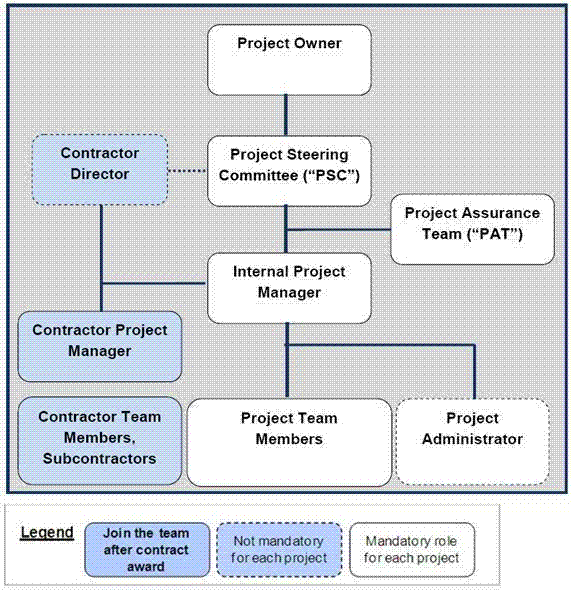Practice Guide to Project Management for IT Projects under an Outsourced Environment
1. Purpose
The purpose of this document provides a set of comprehensive and consistent practices for managing IT projects which are implemented under an outsourced environment.
2. Scope
The Guide is applicable to the management of projects with IT activities (in particular, system implementation) outsourced.
3. Overview
3.1 Project Management Lifecycle
The project management lifecycle consists of four phases, namely Initiate, Plan, Execute and Close with project control across the whole lifecycle.
Initiate
The initiation of a project is signified by a sound business case. When a project is created to solve a problem, address a need or deliver benefits, a budget and further management commitment is required. A project manager (referred to as the Internal Project Manager or Internal PM in short) is thus appointed by the Project Owner at the beginning of project initiation. On the one hand, the Internal PM prepares or assists to prepare the funding application for the project and on the other hand, assists the Project Owner (or his/her delegate in the PSC) to identify the necessary resources and team members needed to develop the project results. The Internal PM should be in place throughout the project lifecycle to ensure project success
Plan
Upon project funding approval, the Internal PM should develop a project management plan (the PMP) that encompasses management of various aspects of the project including organisation, scope, schedule, financial, procurement, communications, risk and issue, quality, logistics, and change. This PMP originates from the funding application and is further developed to pitch at a level sufficient to acquire resources necessary to proceed to the next phase. Subsequent phases of the project work will continue to be planned in greater details as the project progresses (e.g. system testing and implementation details may not be worked out until later in the Execute phase). At the conclusion of the Plan phase, the business case is revisited based on the planning documents and a decision on whether to proceed to the next phase is made.
Execute
Activities are conducted to achieve the project objectives in accordance with the PMP developed from the Plan phase. The majority of the resources are expended in this phase and the primary task of the Internal PM is to ensure that resources are available as and when required to execute the tasks as defined in the project schedule. Under the Government context, this phase can broadly be divided into two sub-phases which are the tendering process and the development of required project deliverables through outsourced services. The Internal PM uses the management processes defined in the PMP to manage the project and monitor contractors' work. The Internal PM also assists the Project Owner/the PSC to prepare the project organisation for the implementation of the project deliverables. During the Execute phase, it is important to revisit the business case at project checkpoints to ensure its continual viability and that the project maintains alignment with the business objectives. When the project transits from the tendering sub-phase to the next sub-phase, the Internal PM should refine the PMP in collaboration with the contractor. This ensures, on the one hand, the contractor understands the project objectives, timeline, management processes and plans while on the other hand, aligns the PMP with the project plan of the contractor.
Close
In the Close phase, the Internal PM assists the Project Owner/PSC to assess the project outcomes to find out if the project objectives have been achieved and whether the project has delivered the business benefits envisaged. Sometimes, it takes time to realise the business benefits from delivery and acceptance of the project deliverables. In this case, the project remains open and the Project Owner, the PSC and the Internal PM should remain onboard until the business case evaluation is completed.
Monitor and control procedures are in place in each of the above phases to ensure that the project is progressing in the right direction. It is managed through processes including change management, risk and issue management, quality management and deliverable acceptance procedures.
3.2 Project Organisation Structure
The project organisation is an organisational body that champions, manages and executes the project. Members within the project organisation work hand-in-hand to achieve the project objectives. Under an outsourced environment, the project organisation is comprised of members from both internal Government resources and external contractor resources. While the delivery of project deliverables mainly lies in the responsibilities of the contractor, it is essential to have participation of the Project Owner/the PSC and the Internal PM throughout the project lifecycle, from project initiation to project closure. The Project Owner/the PSC champions the project, ensures alignment of the project objectives with the B/D’s overall business strategies and is the ultimate decision-maker for the project. The Internal PM manages the project and monitors the contractor’s work on a day-to-day basis for the Project Owner/the PSC.





 Click here to download PDF file of Practice Guide to Project Management for IT Projects under an Outsourced Environment
Click here to download PDF file of Practice Guide to Project Management for IT Projects under an Outsourced Environment